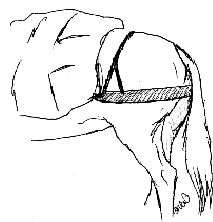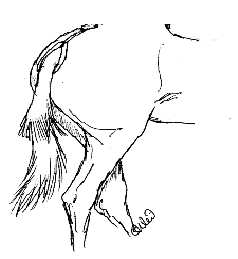|
Holding It On or Holding It Down by Leah Posey Patton
Martingales, tie downs, breast collars, breastplate, britchin and crupper may be terms familiar to most mule enthusiasts, but the items themselves and their use might not be. All of these items are pieces of tack used either to position and maintain headset of the mule or to help keep the saddle in place.
Remember the nature of the mule=s head - the more excited he gets, the higher the head tends to go. Mules are sometimes that way. If your mule is low-headed, even at speed a tie down is inappropriate. If a mule decides to carry his nose out and down, there is the danger of getting a foreleg through the tie down and it should not be used in these cases.
The tie down consists of a thin nose loop (usually a cable bosal)
with an attached strap. The strap may clip on or be woven to
the noseband. The strap runs down through the ring on the
breast collar and attaches to the forward ring of the western
cinch. It should be slack enough to that the mule can stand
comfortably with his head in a natural position with
The English equivalent of the tie down is the
Standing Martingale.
It has a separate headstall (crownpiece and noseband) and strap
that runs down the
To properly adjust a standing martingale, you should be able t lift the slack to touch the mule=s throat when he is standing naturally. The standing martingale is occasionally seen on jumpers, but should be used on hunters. Check rulebooks to see if they are allowed in pleasure classes. Many rulebooks prohibit them.
This is good for just the occasional head tosser. Rein stops (little leather tabs placed snugly on the rein) should always be used with a running martingale. This prevents the rings of the Y from running up to the bit (which happens when the animal lowers the head and the face goes behind the vertical) andcatching on the rein buckles. Running martingales can be used on jumpers. Check rulebooks. Running martingales are always used with snaffle bits
Breastplates are used
with English or cut back saddles and are narrow, flat (usually
leather) straps that fit snug to the chest. They are usually a
single flat b
Western breast collars
is the equivalent to the English breastplate. It is made in a
Y-shape and is wider. It may be made of leather, synthetic or
even lined with fleece to coordinate colors. Breast collars are
used on working stock and with gaming tack to ensure the
stability of the saddle. With show tack, the breast collars are
made to match the show saddles and can be as ornate as the
saddle itself.
Breeching (britchin) is the term used for the equipment derived from harness that goes over the mule=s rear. Britchin is used with pack saddles and harness to keep the saddle from sliding forward or to aid the harness animal in backing. Full Breeching is not usually seen on saddle mules and is not appropriate for pleasure classes, although many pack/working saddle mules might wear them everyday for riding and work.
Cruppers are developed from full britchin. The crupper is a shaped tailpiece, attached at the back of the saddle and run under the mule=s tail. A variety of styles may be seen suitable for use with English or western saddles. Cruppers are usually allowed in most mule classes. The crupper should always be carefully fitted to the mule - not only smoothly under the tail. But for slack as well. A crupper that hangs 2 inches below the dock of the tail is not going to help much with a sliding saddle.
A good fitting saddle and a well trained animals that does not need extra aids is always the best way to go. But, in the event that extras are needed, be sure they fit properly and always check for wear and tear. Just as you would not want your girth or stirrup leather to suddenly give way, it could mean problems if your martingale suddenly broke and wrapped around a fore leg or the crupper rode farther down under the clamped tail of the mule. Be sure your mule is accustomed to being ridden with the extra tack at home - not at a show for the first time. Likewise, try and see if they will work without it, in the event that a break should occur. You don=t want a mule that refuses to move without his britchin!
|
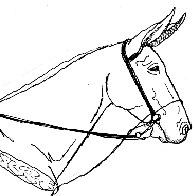 The
Western tie down is not
meant to force an animal
The
Western tie down is not
meant to force an animal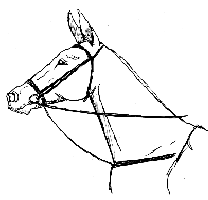 tension on the strap.
tension on the strap.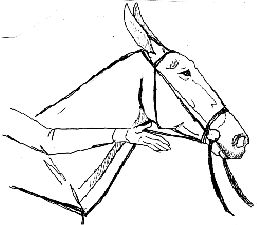 girth.
Some English girths have a front ring to clip to. If not, make
sure your martingale has a loop end to slid over the girth. If
you are using this type of fastener, but sure to slide the girth
through the loop before tightening the girth. Otherwise you
will have to ungirth and start over again.
girth.
Some English girths have a front ring to clip to. If not, make
sure your martingale has a loop end to slid over the girth. If
you are using this type of fastener, but sure to slide the girth
through the loop before tightening the girth. Otherwise you
will have to ungirth and start over again.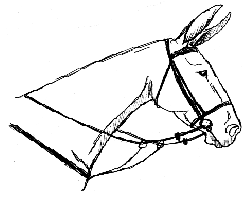 The
Running Martingale
s the other English headset aid. The martingale
is on a separate neck strap, usually run through the D rings on
the front of the saddle. It will also have a strap that runs
back to the girth. Instead of a headstall, the running
martingale is Y-shaped above the breast strap, with rings on the
end of the Y. The reins are run through the rings and rebuckled.
This works with the rider
The
Running Martingale
s the other English headset aid. The martingale
is on a separate neck strap, usually run through the D rings on
the front of the saddle. It will also have a strap that runs
back to the girth. Instead of a headstall, the running
martingale is Y-shaped above the breast strap, with rings on the
end of the Y. The reins are run through the rings and rebuckled.
This works with the rider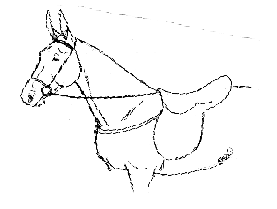
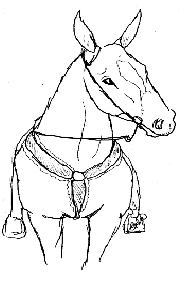 and
with a drop strap to the girth. Their use is designed to keep
the saddle in place and come in handy in
jumping, cross country and hacking.
and
with a drop strap to the girth. Their use is designed to keep
the saddle in place and come in handy in
jumping, cross country and hacking.